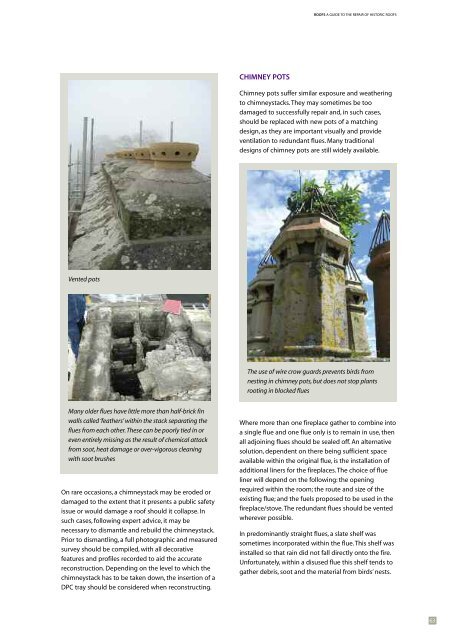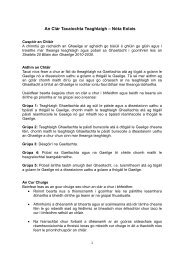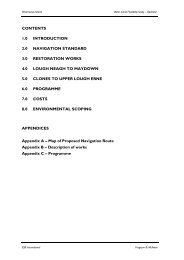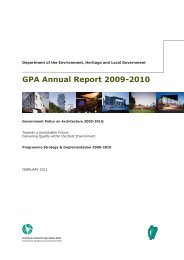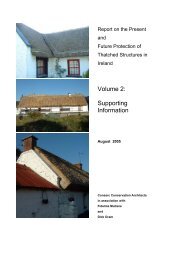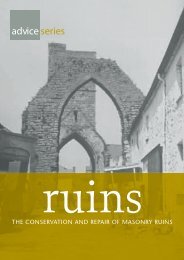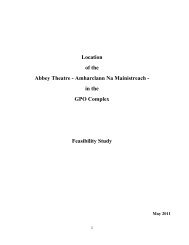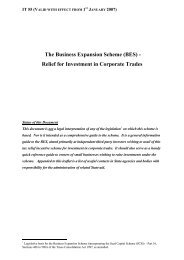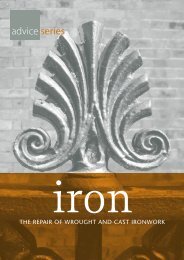A Guide to the Repair of Historic Roofs - Dublin City Council
A Guide to the Repair of Historic Roofs - Dublin City Council
A Guide to the Repair of Historic Roofs - Dublin City Council
Create successful ePaper yourself
Turn your PDF publications into a flip-book with our unique Google optimized e-Paper software.
ROOFS A GUIDE TO THE REPAIR OF HISTORIC ROOFSCHIMNEY POTSChimney pots suffer similar exposure and wea<strong>the</strong>ring<strong>to</strong> chimneystacks. They may sometimes be <strong>to</strong>odamaged <strong>to</strong> successfully repair and, in such cases,should be replaced with new pots <strong>of</strong> a matchingdesign, as <strong>the</strong>y are important visually and provideventilation <strong>to</strong> redundant flues. Many traditionaldesigns <strong>of</strong> chimney pots are still widely available.Vented potsThe use <strong>of</strong> wire crow guards prevents birds fromnesting in chimney pots, but does not s<strong>to</strong>p plantsrooting in blocked fluesMany older flues have little more than half-brick finwalls called ‘fea<strong>the</strong>rs’ within <strong>the</strong> stack separating <strong>the</strong>flues from each o<strong>the</strong>r. These can be poorly tied in oreven entirely missing as <strong>the</strong> result <strong>of</strong> chemical attackfrom soot, heat damage or over-vigorous cleaningwith soot brushesOn rare occasions, a chimneystack may be eroded ordamaged <strong>to</strong> <strong>the</strong> extent that it presents a public safetyissue or would damage a ro<strong>of</strong> should it collapse. Insuch cases, following expert advice, it may benecessary <strong>to</strong> dismantle and rebuild <strong>the</strong> chimneystack.Prior <strong>to</strong> dismantling, a full pho<strong>to</strong>graphic and measuredsurvey should be compiled, with all decorativefeatures and pr<strong>of</strong>iles recorded <strong>to</strong> aid <strong>the</strong> accuratereconstruction. Depending on <strong>the</strong> level <strong>to</strong> which <strong>the</strong>chimneystack has <strong>to</strong> be taken down, <strong>the</strong> insertion <strong>of</strong> aDPC tray should be considered when reconstructing.Where more than one fireplace ga<strong>the</strong>r <strong>to</strong> combine in<strong>to</strong>a single flue and one flue only is <strong>to</strong> remain in use, <strong>the</strong>nall adjoining flues should be sealed <strong>of</strong>f. An alternativesolution, dependent on <strong>the</strong>re being sufficient spaceavailable within <strong>the</strong> original flue, is <strong>the</strong> installation <strong>of</strong>additional liners for <strong>the</strong> fireplaces. The choice <strong>of</strong> flueliner will depend on <strong>the</strong> following: <strong>the</strong> openingrequired within <strong>the</strong> room; <strong>the</strong> route and size <strong>of</strong> <strong>the</strong>existing flue; and <strong>the</strong> fuels proposed <strong>to</strong> be used in <strong>the</strong>fireplace/s<strong>to</strong>ve. The redundant flues should be ventedwherever possible.In predominantly straight flues, a slate shelf wassometimes incorporated within <strong>the</strong> flue. This shelf wasinstalled so that rain did not fall directly on<strong>to</strong> <strong>the</strong> fire.Unfortunately, within a disused flue this shelf tends <strong>to</strong>ga<strong>the</strong>r debris, soot and <strong>the</strong> material from birds’ nests.63


